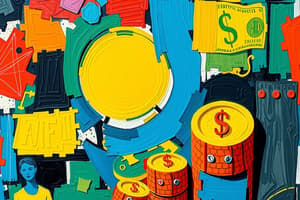Podcast
Questions and Answers
What type of costs arise from efforts to prevent defects?
What type of costs arise from efforts to prevent defects?
- Appraisal Costs
- Prevention Costs (correct)
- External Failure Costs
- Internal Failure Costs
Which of the following costs is typically easier to estimate?
Which of the following costs is typically easier to estimate?
- Prevention Costs (correct)
- Customer Dissatisfaction Costs
- Appraisal Costs (correct)
- External Failure Costs
What is the primary benefit of increasing expenditure on preventive measures?
What is the primary benefit of increasing expenditure on preventive measures?
- Increased customer dissatisfaction
- Significant reduction in appraisal and failure costs (correct)
- Enhanced product design verification
- Higher internal failure costs
Which of the following is NOT an example of internal failure costs?
Which of the following is NOT an example of internal failure costs?
Crosby's statement 'Quality is Free' primarily suggests that investing in which type of costs yields savings?
Crosby's statement 'Quality is Free' primarily suggests that investing in which type of costs yields savings?
Which type of costs arise from identifying defects through tests and audits?
Which type of costs arise from identifying defects through tests and audits?
What type of cost arises from defects that are discovered and handled internally?
What type of cost arises from defects that are discovered and handled internally?
Which of the following would be classified under external failure costs?
Which of the following would be classified under external failure costs?
What defines tangible benefits in the context of quality management?
What defines tangible benefits in the context of quality management?
According to Deming, what is the primary reason for poor quality?
According to Deming, what is the primary reason for poor quality?
How does high quality impact a company according to Deming's philosophy?
How does high quality impact a company according to Deming's philosophy?
What does Deming's Chain Reaction illustrate?
What does Deming's Chain Reaction illustrate?
Which of the following is NOT a category of quality costs as per the text?
Which of the following is NOT a category of quality costs as per the text?
What is essential for implementing a cost-of-quality strategy?
What is essential for implementing a cost-of-quality strategy?
What benefit does a firm gain from achieving higher quality according to the details provided?
What benefit does a firm gain from achieving higher quality according to the details provided?
Which of the following is a component of Deming's continual improvement philosophy?
Which of the following is a component of Deming's continual improvement philosophy?
What is included in prevention costs?
What is included in prevention costs?
Which of the following costs is classified as an appraisal cost?
Which of the following costs is classified as an appraisal cost?
Internal failure costs do NOT include which of the following?
Internal failure costs do NOT include which of the following?
External failure costs arise from what type of product issue?
External failure costs arise from what type of product issue?
Which of the following is a component of prevention costs?
Which of the following is a component of prevention costs?
Appraisal costs typically involve which activity?
Appraisal costs typically involve which activity?
Which cost is NOT considered an internal failure cost?
Which cost is NOT considered an internal failure cost?
Which of the following is a consequence of external failure costs?
Which of the following is a consequence of external failure costs?
What can result from unnecessary transportation in a business?
What can result from unnecessary transportation in a business?
Which type of waste is primarily associated with the costs of unused labor time?
Which type of waste is primarily associated with the costs of unused labor time?
How do additional processing costs arise?
How do additional processing costs arise?
What represents a limitation caused by holding excess inventory?
What represents a limitation caused by holding excess inventory?
What potential costs are associated with defects in a production process?
What potential costs are associated with defects in a production process?
What is a primary consequence of unnecessary motion in a workplace?
What is a primary consequence of unnecessary motion in a workplace?
What type of waste incurs costs related to the obsolescence of products?
What type of waste incurs costs related to the obsolescence of products?
Which of the following is a potential intangible benefit of managing waste effectively?
Which of the following is a potential intangible benefit of managing waste effectively?
What is Muda in the context of lean process thinking?
What is Muda in the context of lean process thinking?
Which of the following describes the waste of waiting?
Which of the following describes the waste of waiting?
What negative effect can over-production have on a company?
What negative effect can over-production have on a company?
What is one of the consequences of defects in production?
What is one of the consequences of defects in production?
How does over-processing waste resources?
How does over-processing waste resources?
Which of the following terms refers to activities that do not add value?
Which of the following terms refers to activities that do not add value?
What does the concept of 'non-value-added activities' refer to?
What does the concept of 'non-value-added activities' refer to?
What are the Seven Wastes as identified by Ohno primarily associated with?
What are the Seven Wastes as identified by Ohno primarily associated with?
Flashcards are hidden until you start studying
Study Notes
Cost of Quality
- Prevention costs involve efforts to prevent defects from occurring
- Appraisal costs are associated with detecting defects
- Internal failure costs arise from defects that are caught internally and dealt with by discarding or repairing the affected items
- External failure costs occur when defects reach the final customer
- Prevention costs are the most vital, but appraisal, internal, and external failure costs are easier to collect
- Even a small increase in prevention costs can significantly reduce appraisal and failure costs
Deming's Chain Reaction
- The Deming Chain Reaction model suggests that improvements in quality lead to lower costs, higher productivity, and increased market share
- Deming's approach emphasizes the importance of reducing variation in processes to improve quality
- Higher quality leads to higher productivity and long-term competitive strength
Seven Types of Waste (MUDA)
- Muda means ‘wastefulness’
- The seven types of waste are:
- Waiting
- Defects
- Over-production
- Over-Processing
- Transportation
- Inventory
- Motion
- Waiting refers to time spent waiting for materials, information, or processes
- Defects result in rework or discarding of products
- Over-production occurs when more products are produced than demanded
- Over-processing refers to unnecessary work performed on a product
- Transportation is the unnecessary movement of products within the company
- Inventory refers to the storage of raw materials, work-in-process, or finished products
- Motion relates to unproductive movement of people or equipment
- Understanding and eliminating these wastes can lead to significant improvements in efficiency and profitability
Intangible Benefits
- Intangible benefits of quality management include:
- Enhanced customer satisfaction
- Improved employee morale
- Increased company reputation
- Stronger relationships with suppliers
- Greater innovation and competitiveness
- These benefits are difficult to measure financially, but they are crucial for long-term success
Studying That Suits You
Use AI to generate personalized quizzes and flashcards to suit your learning preferences.




